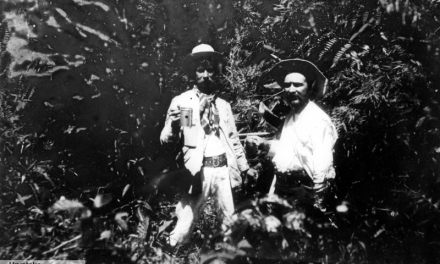A culture exceeding five thousand years
The Lasinja Culture is among the most important prehistoric cultures in Croatia, even though the culture of the Copper Age (Eneolithic, Age 3700-3200 BC) in northern Croatia used only stone and was mostly involved in agriculture. It was named after the site in Lasinja. Some of the archaeological findings can be seen at the Karlovac City Museum.
A small cult bottle from Vrlovka
The Karlovac City Museum exhibits a completely preserved bottle from the Late Stone Age (Neolithic Age), which is about 3500 years old, and it was found in the Vrlovka Cave near Kamanje. The bottle is one of the most important ceramic findings of Lasinja culture. A cult rattle, in the form of a bi-conical bottle is 9 centimetres tall. The ochre-gray surface is richly decorated with white ornaments.
A majestic ancient ‘pyramid’
Humak is a name used in the Karlovac area for a mound (tumulus) covered by landfill or mound land or stones, built for funerals, rituals or defences. According to archaeological findings, the oldest mounds date from the Middle Bronze Age approximately 4,000 years ago. Some, like the mounds in Hrsina and Veljunski točak, are bigger than a single-storey house and as long as half a football field.
Bronze from an unconquerable cave
The Gajina Cave in the gorge of the Korana River near Drežnice Selište is important because of the ancient findings discovered in it. Close to it, the items discovered ranged from jewellery to tools, and dated from the Late Bronze Age. The findings are now kept in the Archaeological Museum in Zagreb. Gajina Cave, although only 65 meters long, is special due to its two holes in the vertical cliff above the river. The lower and higher entrance was once walled up with two walls, and someone could get to the lowest one only by ladder, whilst the cave was used (especially during the conquest of the Turks) as a hideout and a ‘defence tower’. Today, the surrounding cliff serves as a training ground for mountaineers.
The riches collection of idols in Croatia
The Karlovac City Museum holds the richest collection of ancient art figurines in Croatia. A collection of some 500 clay idols from the early Iron Age (dating from the 9th to the 4th century BC) come from the Turska kosa archaeological sites near Topusko, which has been explored since the 1980s. The local idols are an inventory belonging to the Kolapijani Triber.
Viničica – the Croatian Masada
The greatest pre-Romanic city on Croatian territory, the Iapodian Metulum capital (on Viničica Hill near Josipdol) was captured by the Romans led by Octavian (later the first Roman Emperor Augustus) 35 years before Christ. According to the Roman historian Appian, the Iapodians committed mass suicide to avoid enslavement, just as in the year 73 the Jewish defenders of Masada, the fortress near the Dead Sea had done.
A chapel built from sarcophagus
The Church of St. George in Mateško Village is the only medieval church in the Karlovac area and is the best preserved on the Ottoman Empire border. As studies showed in 1999, the material used in construction was usurped Roman sarcophaguses. Between the Kupa and Korana Rivers in Roman times (3rd century), there were around 40 or so quarries used to make sarcophaguses. Sarcophagus boxes and lids together could weigh up to 5 or 6 tons. In the production locations, damaged and incomplete versions can be seen.
Roman colony on the Mrežnica River
In Sveti Petar (Saint Peter) on Mrežnica near Duga Resa, according to the historian Quadrata from the 3th and 4th century, there existed an important old Roman settlement. In the local church of St Peter and around it, there is evidence of inscriptions and reliefs in stone, fragments of statues, pottery and money. In Mrežnica, there are visible traces of regular walls, partly hidden under the river detritus.
Antiques from the river sludge
The fact that riverbeds are archaeological sites is testified by the fragments of imported Roman bronze sculptures dating from the first century and found in the Kupa River near Kamensko. In one of the fragments, an usual presentation of the Apollo God can be seen. In 1997, a three-ton heavy lid sarcophagus was extracted from the Korana River, near Gornji Šćulc. Half of it can now be found in the yard of Barilović Old Town and the other half in front of the Church of St. Peter in Sveti Petar Mrežnički. Both findings were probably left in the rivers after a shipwreck.
The secret of deformed skull
One of the more puzzling archaeological findings in Croatia is certainly a deformed skull found in Jopić Cave on Kordun River. This is a skull of a violently murdered woman dating back to the 3rd century. The skull was deliberately elongated during the first years of her life. The skull is preserved in the Paleontological institute of the Croatian Academy of Sciences and Arts in Zagreb.
Resurrected ceramics of the ancient Lapydes
Janja Gora, not far from Plaški, has since 2006 become during the summer the centre of an international colony of potters dedicated to reviving the ancient art treasures of the Lapydes, who lived in Roman times near today’s Lika, Kordun and western Bosnia. The host of the colony is ’Atelier of Ceramic Works’ at Janja Gora, the place of traditional handmade ceramic art and useful items made of clay. Here again, the forgotten ceramic works are revived and new ceramic achievements reviewed. This is carried out by burning wood and gas, ash glazing and various other natural substances, they build and use earth ovens, paper…






